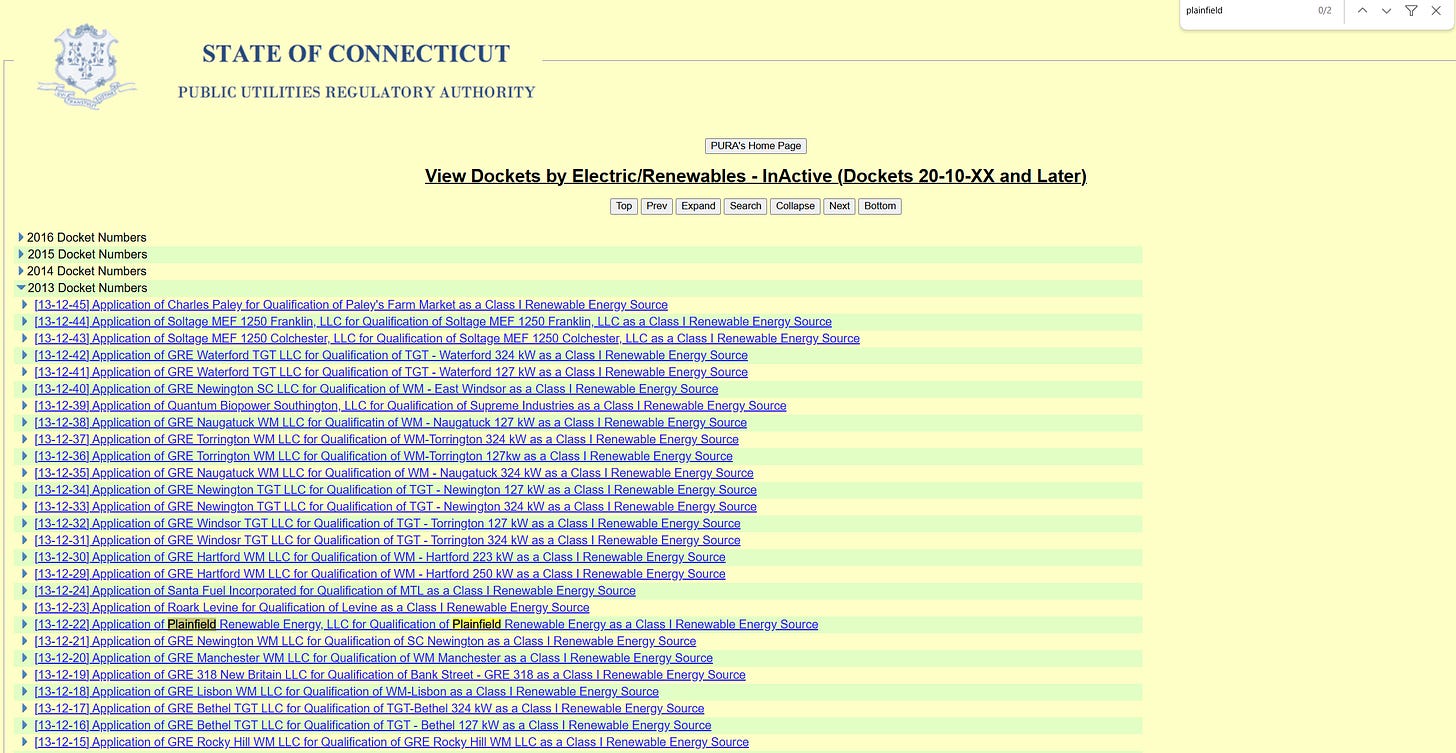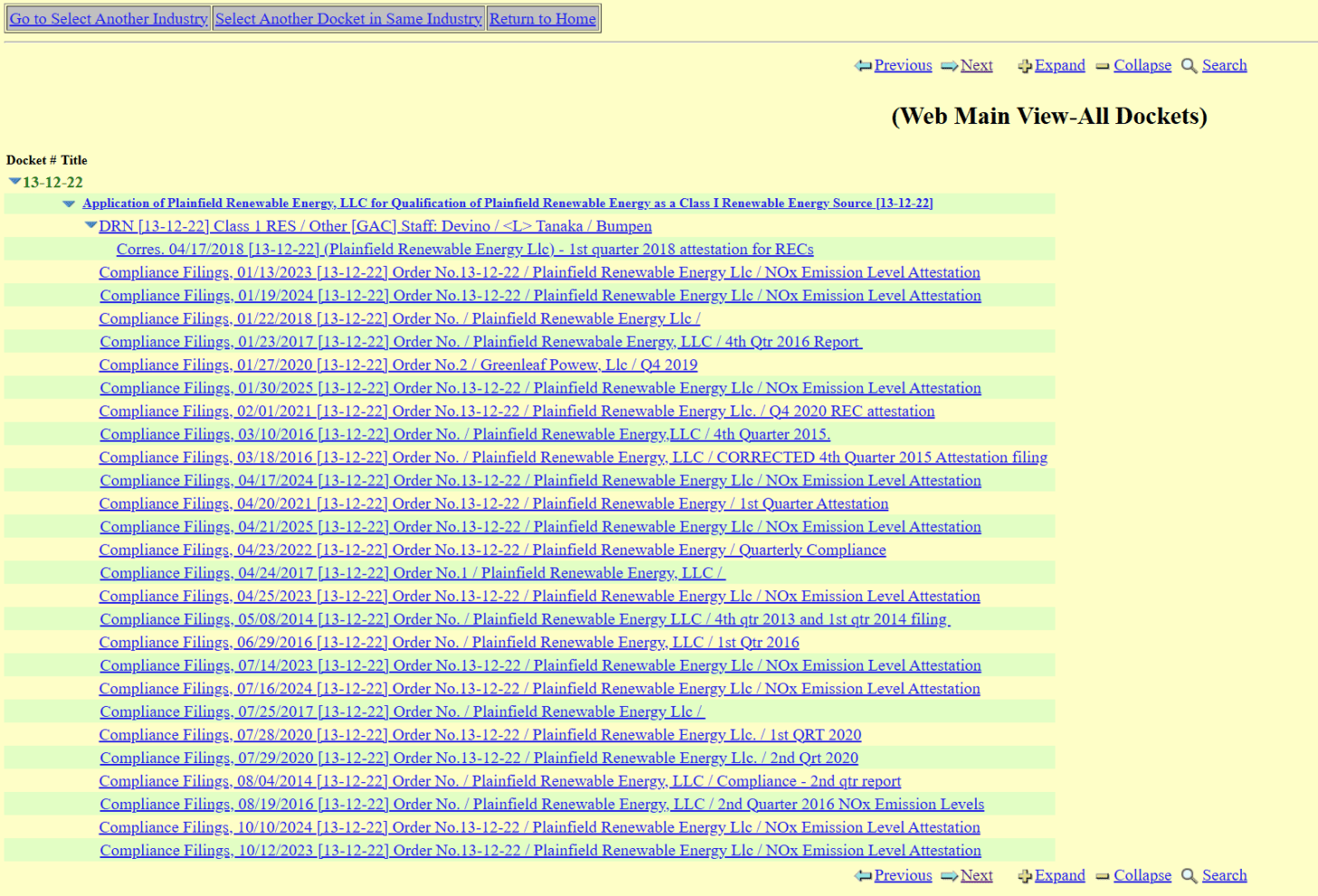BONUS: What “Public Data” Looks Like
i'm screaming at my computer right now why is it this bad
On 15 January 2025, Greenleaf Power, operator of the Plainfield Renewable Energy biomass power plant ran into a problem: The September 2024 Renewable Energy Credits (RECs) they expected on this day came out wrong.
The Plainfield plant is nominally eligible for Connecticut Class 1 RECs, worth $30-38/MWh on semi-open REC markets. A new biomass plant would not be eligible for such RECs,1 but the Plainfield plant is grandfathered in. However, its eligibility depends on entering emissions data into the New England Power Pool (NEPOOL) General Information System (GIS) that mints and tracks RECs.
This…didn’t happen. Per their 19 Feb 2025 letter to the Connecticut Public Utilities Regulatory Authority (PURA):
[Due] to an inadvertent administrative error that [the Plainfield plant] did not discover until after the Q3 RECs were issued on January 15, 2025, the Company determined that the September emissions data, unlike the July and August emissions data, had not been entered into NEPOOL GIS. Due to this inadvertent error, the Plainfield Facility was issued approximately 15,679 RECs for the Q3 period (the “September RECs”) that were not designated as Connecticut Class I compliant. Thus, only the July and August Connecticut Class I RECs could be transferred to Eversource as stipulated in the PPAs. [Emphasis mine.]
This oopsie allegedly cost Greenleaf more than $700,000.2 This was worth a support ticket. So, Greenleaf pinged APX, the environmental market administration firm that runs the GIS system. “Hey, we mis-typed a few numbers; can you reach into the backend of the software you manage to fix this?”
And APX, representing NEPOOL, said no. Particularly, they told Greenleaf to take it up with PURA, because they’re the ones who actually decide what a REC is. Greenleaf did as told.
The Connecticut Office of Education, Outreach, and Enforcement (EOE) submitted the only comment, saying, effectively, “skill issue.” Greenleaf should have simply followed the rules. PURA then denied Greenleaf’s request, citing an earlier ruling in which they concluded:
[There] is no statutory authority by which the Authority can reclassify or recognize a REC as Class I-eligible if it is not designated as such in NEPOOL GIS.
You may have noticed that this ruling constitutes a mutual buck-passing: APX, representing NEPOOL, denies that they have the authority to rectify this REC error without PURA’s say-so, and PURA denies that they have the authority to rectify this REC error without NEPOOL’s say-so.
This problem will not get solved. This current article is likely the only source “breaking this news.” But this information is—notionally—“open to the public.”
But Good Luck Accessing That Information
This is the actual point of the post: how would you, an ordinary member of the public, learn any of this information? It’s simple!
Log onto portal.ct.gov/pura
Click “Search for Docket by Number.” Revel in the ‘90s Beige Box web design that greets you.
Type in the docket number you’re interested in—in this case, it's 13-12-22
Confirm the docket title that pops up
Click “Submit”
But what if you didn’t have the docket number? In that case, you can:
Log onto portal.ct.gov/pura
Click “Docket Information”
Click “Active Dockets.” Fail to find anything. Go back.
Click “Inactive Dockets.” End up on the same page but scrolled down halfway.
Scroll to “Inactive (2010 or later).” Click “Electric Renewables.”
Scroll or Ctrl-F through a wall of links, year by year, until you find the docket you’re looking for.
Once you have the right docket number, you’ll find a page view that looks like this:
The filings are not organized by dates. You must scan through the docket with the “Previous” and “Next” keys. You cannot change how many rows are displayed. The “Expand” and “Collapse” buttons make things worse. The “Search” button drops you into the “loading program” from The Matrix.
The Massachusetts DPU interface has that we-have-Salesforce-at-home look but won’t let you use two filters at once. The New Hampshire PUC interface doesn’t have any search function—either you know what docket you’re looking for, or you open a list of all filings in the past 7, 30, or 60 days.3 The Vermont PUC interface requires you to set up an account first, but at least it has a search function worth a damn…as well as search functions that are useless. And the Rhode Island PUC interface is a single static webpage full of links.
This is what “publicly available information” looks like: janky, ugly, impenetrable tragedies of software that assume you already know what you’re looking for. A single software engineer with 5ish TB of AWS storage space could build a database that downloads and organizes all New England electric PUC dockets going back to the ‘90s in one fell swoop. Throw in a Claude integration to generate no-brainpower summaries for dockets, and you’ve got a product. But even that business model is only useful to lawyers, consultants, and, well, me. If you’re a regular person, you’re stuck with these god-awful day-ruining interfaces don’t want yokels like you snooping into the important business of keeping the lights on, and such.
I have three hypotheses about why we’re in this state of affairs, all damning:
State agencies like Connecticut PURA do not actually know what good software looks like.
State agencies like Connecticut PURA know their docket interface is terrible but have lacked the means, funding, or administrative buy-in to build a good interface…for twenty-plus years.
State agencies like Connecticut PURA know their docket interface is terrible and have concluded it’s in their best interest for regular journalists, voters, and ratepayers not to have practical access to these public records.
This is the state of the electric grid. The rot goes this far down.
If you’re a cracked backend engineer with AI integration chops and 3-7 hours/week to burn, (or know someone who is) ping me at f.ichiro.gifford@gmail.com. I think this business could generate ARR in the $100,000/year realm with a team of two working part-time for nine months. It could scale from there. EDIT 2025-06-12 actually that kind of ARR might not be possible lmao
This post and the information presented are intended for informational purposes only. The views expressed herein are the author’s alone and do not reflect those of their current or previous employers or any elected officials. The author makes no recommendations toward any electric utility, regulatory body, or other organization. While certain information contained herein has been obtained from sources believed to be reliable, the author has not independently verified this information, and its accuracy and completeness cannot be guaranteed. Accordingly, no representation or warranty, express or implied, is made as to, and no reliance should be placed on, the fairness, accuracy, timeliness or completeness of this information. The author assumes no liability for this information and no obligation to update the information or analysis contained herein in the future.
And that’s if the Conservation Law Foundation would let you install such a plant.
Greenleaf losing $700k implies they’re getting $45/MWh for RECs. But I don’t know why Eversource would pay that much for RECs—a normal CT 1 REC costs, you’d be looking at a loss between $450k and $600k. This explainer from 2017 claims Connecticut’s Class 1 alternative compliance payment is $55/MWh, but the primary-source statutes have no such numbers.
You’re checking a docket from five years ago for research purposes? Get bent.




